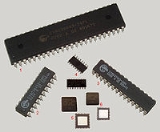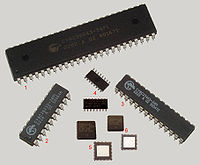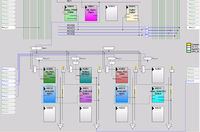
PSoC
Encyclopedia


Integrated circuit
An integrated circuit or monolithic integrated circuit is an electronic circuit manufactured by the patterned diffusion of trace elements into the surface of a thin substrate of semiconductor material...
s made by Cypress Semiconductor
Cypress Semiconductor
Cypress Semiconductor Corporation is a Silicon Valley-based semiconductor design and manufacturing company founded by T. J. Rodgers and others from Advanced Micro Devices. It was formed in 1982 with backing by Sevin Rosen and went public in 1986. The company initially focused on the design and...
. These chips include a CPU and mixed-signal
Mixed-signal integrated circuit
A mixed-signal integrated circuit is any integrated circuit that has both analog circuits and digital circuits on a single semiconductor die.- Examples :...
arrays of configurable integrated analog and digital peripherals.
History
Commercial PSoC shipments began in 2002.To promote the PSoC, Cypress sponsored a "PSoC Design Challenge" in Circuit Cellar
Steve Ciarcia
Steve Ciarcia is an embedded control systems engineer. He became popular through his Ciarcia's Circuit Cellar column in BYTE magazine, and later through the Circuit Cellar magazine that he published...
magazine in 2002 and 2004.
PSoC is used in devices as simple as Sonicare toothbrushes and Adidas sneakers, and as complex as the TiVo
TiVo
TiVo is a digital video recorder developed and marketed by TiVo, Inc. and introduced in 1999. TiVo provides an on-screen guide of scheduled broadcast programming television programs, whose features include "Season Pass" schedules which record every new episode of a series, and "WishList"...
set-top box. One PSoC, using CapSense, controls the touch-sensitive scroll wheel
Scroll wheel
A scroll wheel is a hard plastic or rubbery disc on a computer mouse that is perpendicular to the mouse surface. It is normally located between the left and right mouse buttons.- Functionality :...
on the Apple iPod click wheel
IPod Click Wheel
The iPod click wheel is the navigation component of several iPod models. It uses a combination of touch technology and traditional buttons, involving the technology of capacitive sensing, which senses the energy of the user's fingers. The wheel allows a user to find music, videos, photos and play...
.
Description
PSoC is a software configured, mixed-signal array with a built-in MCU core.There are three different family of devices (2009):
- CY8C2xxxx Named PSoC1 with CPU M8C
- CY8C3xxxx Named PSoC3 with CPU 8051Intel 8051The Intel MCS-51 is a Harvard architecture, single chip microcontroller series which was developed by Intel in 1980 for use in embedded systems. Intel's original versions were popular in the 1980s and early 1990s. While Intel no longer manufactures the MCS-51, binary compatible derivatives remain...
- CY8C5xxxx Named PSoC5 with CPU ARM Cortex M3ARM architectureARM is a 32-bit reduced instruction set computer instruction set architecture developed by ARM Holdings. It was named the Advanced RISC Machine, and before that, the Acorn RISC Machine. The ARM architecture is the most widely used 32-bit ISA in numbers produced...
PSoC has three separate memory spaces: paged SRAM for data, Flash memory
Flash memory
Flash memory is a non-volatile computer storage chip that can be electrically erased and reprogrammed. It was developed from EEPROM and must be erased in fairly large blocks before these can be rewritten with new data...
for instructions and fixed data, and I/O Registers for controlling and accessing the configurable logic blocks and functions. The device is created using SONOS
SONOS
SONOS, short for "Silicon-Oxide-Nitride-Oxide-Silicon", is a type of non-volatile computer memory closely related to Flash RAM. It is distinguished from mainstream flash by the use of silicon nitride instead of polysilicon for the charge storage material. A further variant is "SHINOS"...
technology.
PSoC resembles an ASIC
Application-specific integrated circuit
An application-specific integrated circuit is an integrated circuit customized for a particular use, rather than intended for general-purpose use. For example, a chip designed solely to run a cell phone is an ASIC...
: blocks can be assigned a wide range of functions and interconnected on-chip. Unlike an ASIC, there is no special manufacturing process required to create the custom configuration - only startup code that is created by Cypress' PSoC Designer IDE
Integrated development environment
An integrated development environment is a software application that provides comprehensive facilities to computer programmers for software development...
.
PSoC resembles an FPGA in that at power up it must be configured, but this configuration occurs by loading instructions from the built-in Flash memory. Unlike an FPGA, the current generation of PSoC cannot have its digital functions reprogrammed by VHDL or Verilog
Verilog
In the semiconductor and electronic design industry, Verilog is a hardware description language used to model electronic systems. Verilog HDL, not to be confused with VHDL , is most commonly used in the design, verification, and implementation of digital logic chips at the register-transfer level...
, it can only be configured with register settings.
PSoC most closely resembles a microcontroller
Microcontroller
A microcontroller is a small computer on a single integrated circuit containing a processor core, memory, and programmable input/output peripherals. Program memory in the form of NOR flash or OTP ROM is also often included on chip, as well as a typically small amount of RAM...
in usage, where code is executed to interact with the user-specified peripheral functions (called "User Modules"), using automatically generated APIs and interrupt routines. The PSoC Designer IDE generates the startup configuration code and peripheral APIs automatically based upon the users selections in a Visual-Studio-like GUI.
Cypress offers a visual, code-free embedded design tool for PSoC called PSoC Express. Using PSoC Express, most features of the PSoC can be accessed with drag and drop icons and logical expressions. The visual design
Graphic design
Graphic design is a creative process – most often involving a client and a designer and usually completed in conjunction with producers of form – undertaken in order to convey a specific message to a targeted audience...
is compiled to executable code without exposing the user to the underlying converted code, though a visual design can be converted and used as a basis of a traditional code-based design in PSoC Designer. Visual design elements cover features such as temperature sensors, fan control, accelerometers, I2C master and slave protocols, USB virtual serial ports, capacitive sensors, and wireless 2.4 GHz radio communications. Cypress Semiconductor introduced a new family in its PSoC 3 architecture. Programmable Digital PSoC 3 Family allows the integration of digital peripherals along with PWMs, Timers, Counters, UARTs, glue logic and state machines. It also offers customizable digital functions and interfaces, which lowers overall system power by migrating traditional CPU functions to programmable digital logic.
PSoC Technology
A PSoC integrated circuit is composed of a core, configurable analog and digital blocks, and programmable routing and interconnect. The configurable blocks in a PSoC are the biggest difference from other microcontrollers. PSoC devices include up to 16 digital and 12 analog blocks, depending on the device.The Core
The PSoC1 core includes:- The M8C MCU
- Flash memory
- SRAM
- Sleep and watchdog timers
- Multiple clock sources that include a PLL
- Internal main and low-speed oscillator
- External crystal oscillator for precision, programmable clocking
PSoC1 devices can have up to two multiply–accumulate modules (MACs), which provide fast 8-bit multipliers or fast 8-bit multipliers with 32-bit
32-bit
The range of integer values that can be stored in 32 bits is 0 through 4,294,967,295. Hence, a processor with 32-bit memory addresses can directly access 4 GB of byte-addressable memory....
accumulate, up to two decimators for digital signal processing
Digital signal processing
Digital signal processing is concerned with the representation of discrete time signals by a sequence of numbers or symbols and the processing of these signals. Digital signal processing and analog signal processing are subfields of signal processing...
applications, I2C functionality for implementing either I2C slave or master, and availability of a full-speed USB interface.
Configurable Analog and Digital Blocks

Each digital block is considered an 8-bit resources that designers can configure using pre-built digital functions or user modules (UM), or, by combining blocks, turn them into 16-, 24-, or 32-bit resources. Concatenating UMs together is how 16bit PWMs and timers are created.
There are two types of analog blocks. The continuous time (CT) blocks are composed of an op-amp circuit and designated as ACBxx where xx is 00-03. The other type is the switch cap (SC) blocks, which allow complex analog signal flows and are designated by ASCxy where x is the row and y is the column of the analog block. Designers can modify and personalize each module to any design.
Programmable Routing & Interconnect
PSoC mixed-signal arrays' flexible routing allows designers to route signals to and from I/O pins more freely than with many competing microcontrollers. Global buses allow for signal multiplexing and for performing logic operations. Cypress suggests that this allows designers to configure a design and make improvements more easily and faster and with fewer PCB redesigns than a digital logic gate approach or competing microcontrollers with more fixed function pins.Key Features
- FPGA Configuration via the PSoC(R) Programmable System-on-Chip
- (4) CapSense buttons
- I2C temperature sensor
- (2) 6-pin expansion header
- USB-to-UART bridge interface
- I2C port
- SPI and BPI configuration
- Xilinx JTAG interface
See also
- Field-programmable analog array: field programmable analog array
- Reconfigurable computingReconfigurable computingReconfigurable computing is a computer architecture combining some of the flexibility of software with the high performance of hardware by processing with very flexible high speed computing fabrics like field-programmable gate arrays...
External links
- Cypress Semiconductor Official Website
- PSoC Website - Cypress
- PSoC Developer
- PSoC Zone (the French PSoC Community by ISTASE)
- Psoc-chile El primer web site en Español sobre Microcontroladore Psoc
- Technology solutions

